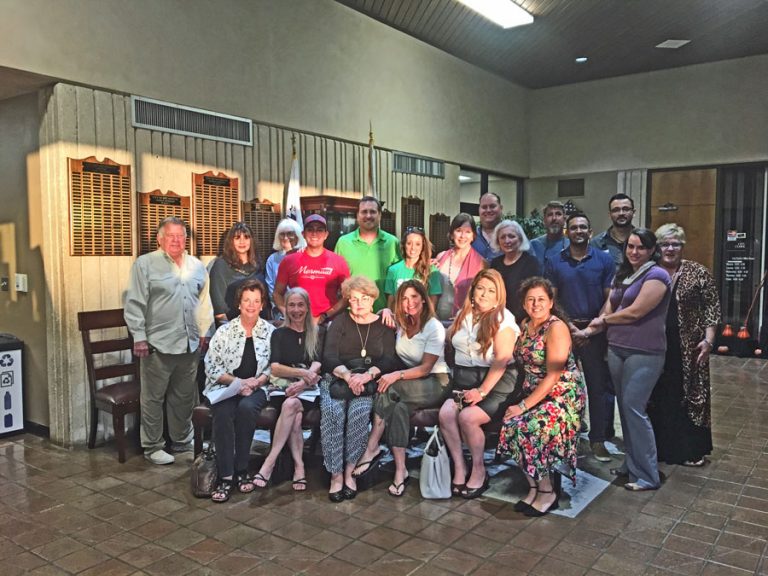

Everyone who came out to support Cape's Dam at the HPC meeting gathered for a photo at the vote.

By, Terra Rivers, Managing Editor
On Thursday, October 4, the San Marcos Historic Preservation Commission held a public hearing to discuss the potential designation of Cape’s Dam as a local landmark.
The meeting opened with public comments in which several people spoke in favor of the dam’s designation as a local landmark; one individual spoke against the designation.
Dianne Wassenich, executive director of the San Marcos River Foundation, again spoke on behalf of SMRF against the designation.
“SMRF wishes to remove the dam because it diverts a third or so of the river,” Wassenich said. “And during dry times, this is critically harmful to the fish and other species both native and endangered in the river. Our endangered species are the only reason we currently have a flowing river; the still mill race is not good habitat no matter how many false claims about that are made.”
Wassenich said if the dam was restored to save the mill race, the city would have to do something about the 1970s concrete along the side of the mill race; she also talked about the public safety issues concerning the dam and other historical features around San Marcos.
“It will be a huge and expensive project to pay for and repay for every time it floods if you decide to rebuild the mill race,” Wassenich said.
Among the other speakers was San Marcos resident Roland Saucedo, Kate Johnson, chair of the Hays County Historical Commission, Brian Olson, Joshua Simpson, former city council member, Jude Prather and Lila Knight.
Saucedo talked about how he learned to canoe on the river with Boy Scouts Troop 116 around Cape’s Dam.
During the public hearing, Knight, a historian, talked about how the dam’s effects on the river and the historical significance of the dam were two separate issues.
Knight said neither issue was on the table for the commission’s consideration tonight.
According to Knight, in 2016, the Texas Historical Commission visited the site of Cape’s Dam and ruled it was still eligible for listing on the National Register.
Commissioners Bob Holder and Alex Arlinghaus both expressed concerns about whether the dam should be removed.
Arlinghaus said he could not support the dam being designated a landmark if the dam impedes “the river’s ability to flow.”
Holder’s concerns regarded requests from members of the community to designate and preserve the dam.
“I don’t believe we’re qualified, I know I’m not, to make a decision about the effect of the dam upon the river,” Holder said.
Holder said he felt designating the dam a landmark would anchor it in place and make it difficult for the city to remove if it truly needed to be.
Commissioners Thea Dake, Ryan Perkins, Greg Standard and Griffin Spell stayed away from the scientific and environmental issues regarding the dam.
“To me, the question that lies before us is, is it historical? Is it a landmark?” Perkins said. “It meets the criteria in every way.”
Additionally, Perkins said the commission had designated at least one local landmark that was later torn down; being designated a landmark doesn’t necessarily mean something can never be torn down or removed.
The designation passed with a 4-2 vote with commissioners Holder and Arlinghaus voting no. Commissioner Diana Baker was absent.
Staff said the designation would go to the Parks and Recreation board for their October 18 meeting before a public hearing will be scheduled for an upcoming Planning and Zoning meeting.
The designation is projected to be addressed in a third public hearing in front of City Council in December.
Featured Image: Everyone who came out to support Cape’s Dam at the HPC meeting gathered for a photo at the vote.
The San Marcos City Council received a presentation on the Sidewalk Maintenance and Gap Infill…
The San Marcos River Rollers have skated through obstacles after taking a two-year break during…
San Marcos Corridor News has been reporting on the incredible communities in the Hays County…
Visitors won't be able to swim in the crystal clear waters of the Jacobs Well Natural…
Looking to adopt or foster animals from the local shelter? Here are the San Marcos…
The Lone Star State leads the nation in labor-related accidents and especially workplace deaths and…
This website uses cookies.
View Comments
The small amount of water that is temporarily diverted into the mill race is returned to the river. It does not disappear.